| <image src="./JMKsmall.jpg" border="0" width = "100"> | Jody M. Klymak<br>School of Earth and Ocean Sciences <br> Department of Physics<br>University of Victoria<br>P.O. Box 3055 STB CSC<br>Victoria, BC Canada, V8W 3P6<br> | Phone: (250)-472-5969<br> Fax: (250)-721-6200<br> Office: 179c<br><a href="mailto:jklymak@uvic.ca">jklymak@uvic.ca</a> |
Small and medium scale ocean flows, and their impacts on larger scale flows: waves, turbulence, fronts, eddies etc. These processes are what ultimately dissipate energy from the mean ocean circulation and mediate the mixing of momentum, heat, salt, and passive tracers.
| Curriculum Vitae | Publications | Teaching |
Rob Pinkel and I participated in an experiment in the South China Sea observing solitary waves propagating through deep water in the basin. We tracked a large number of internal solitary-wave packets as they propagated across the basin, and example of which is shown below.
 |
| Solitary wave in the South China Sea |
<p class="caption"> Solitary wave in the South China Sea, observed propagating westward at 3 m/s.</p>
A great deal of effort has gone into understanding internal waves and turbulence in the ocean using vertical profilers. Horizontal measurements have not been used systematically for the last thirty years. Here we demonstrate that the motions are strongly influenced by turbulence to very long wavelengths, almost 1 km. The low wavenumbers are dominated by internal waves, but do not appear to vary in amplitude much. We explain this by considering the horizontal projection of vertical spectral models onto the horizontal and demonstrate that we are primarily looking at the "saturated" subrange of internal waves.
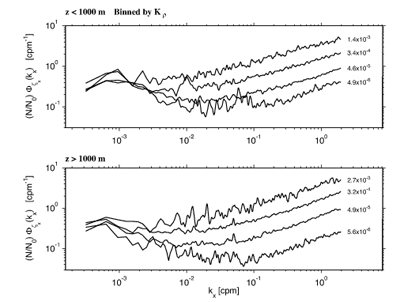 |
| Horizontal spectra ofinternal waves and turbulence |
<p class="caption"> Horizontal spectra of vertical displacement (i.e. isopycnal slope). Spectra are binned by the strength of the turbulence. The red region at low wavenumbers is identified with internal waves, the blue region at high wavenumbers is identified with turbulence.</p>
I am now working as a post-doc with Rob Pinkel. One of the projects I am working on is analyzing data collected using the R/V Revelle's on-board Doppler sonar that Rob and the rest off the OPG group have been running on the Revelle since 1999. Of particular interest are long-fast transects across the Pacific. The goal is to gather a large enough data set to improve our knowledge of internal wave patterns in the ocean.
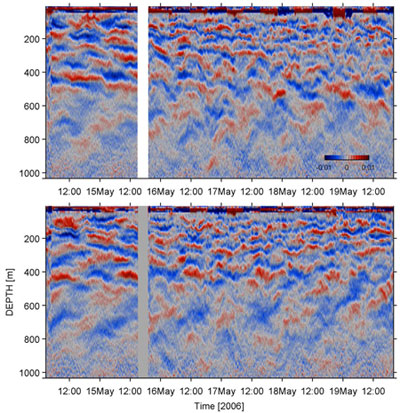 |
| Shear from the R/V Revelle |
I was a post-doc with Jim Moum and the Ocean Mixing Group at Oregon State University. We used a towed microstructure profiler, Marlin, to quantify the turbulence and shear near the Hawaiian Island ridge, a suspected location of strong mixing.
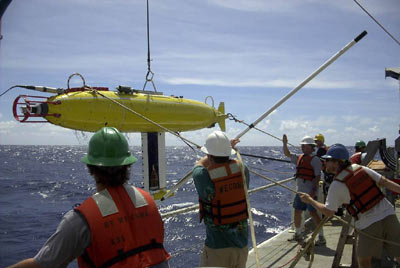 |
| Marlin Recovery |
The Ocean Mixing Group had performed three experiments on the Oregon Coast. Sasha Perlin and Jim Moum are performing most of the analysis. During a recent experiment we observed very large solitary waves of elevation advancing up the Oregon shelf. These waves rode along a near-bottom pycnocline and were a very strong source of shelf turbulence. They also resuspended a lot of sediment.
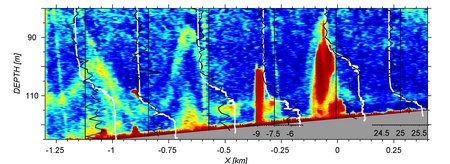 |
| Solitary Waves |
We did work with Parker MacCready and Kate Edwards off Three Tree Point in Puget Sound as well
My thesis work was with Mike Gregg at the Applied Physics Lab, UW. We examined the waves and turbulence generated at the Knight Inlet sill.
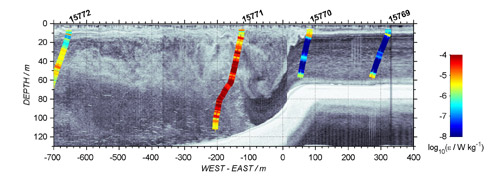 |
| Knight Inlet ebb tide sill flow |
Some other things people may be interested in, including LaTeX style files for American Meteorological Society publications.
 Jody Klymak - jklymak@uvic.ca
Jody Klymak - jklymak@uvic.ca